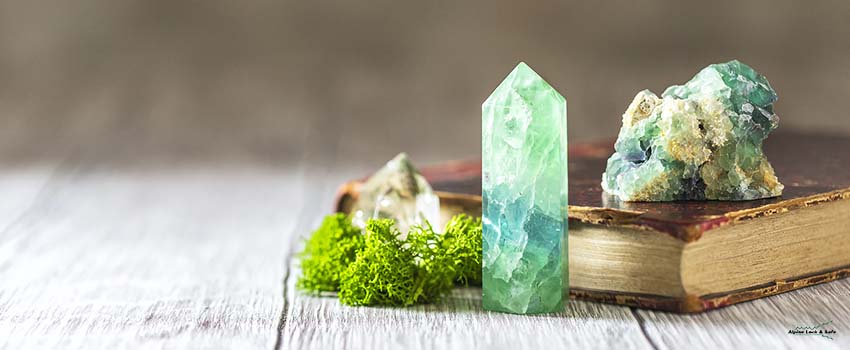If you’ve discovered the beautiful world of gems, now is the time to select the perfect gemstone for your custom jewelry pieces.
Since ancient times, precious stones have attracted humankind and still use them in jewelry. In choosing gemstones for your custom jewelry pieces, you’ll want those that reflect your personality. However, color shouldn’t be your only deciding factor.
Gems were not only used to make jewelry; they were also considered miraculous with mysterious powers in many civilizations. Discover the different types of jewels and how to choose one for yourself or your loved ones with us at Portofino Jewelry.
What Is a Gemstone?
Precious stones are valuable pieces of mineral crystal usually found in the ground. Stones like tourmaline, diamonds, emeralds, and sapphires decorate jewelry and other adornments. Organic minerals like amber, jet, copal, and pearls are also types of gemstones.
According to Britannica, out of the over 2,000 natural minerals identified throughout history, only 100 are considered gemstones; 16 of them have reached international prominence.
Why Should You Invest in Quality Stones?
It is not easy to invest in precious stones. Rare gems are an excellent investment for people who enjoy fine and beautiful jewelry. They are also a reliable way to store value when stock markets fall and currencies lose their value.
Although gems aren’t as liquid as gold, they still retain their value. The demand for fine gems is generally greater than the supply, and their prices tend to move up over time.
Here are some stones worthy of the investment:
- Emerald
- Ruby
- Spinel
- Alexandrite
- Blue Sapphire
- Jadeite Jade
Gemstone Chart: What Are the Things to Consider?
The status and pleasure of owning gemstones were once only felt by nobility and royalty. Today, different gemstones have become more accessible for many to enjoy.
Many factors help you determine the best gems for you, depending on how you intend to wear them. Whether you’re drawn to antiques or modern designs, special stones can delight many generations if they are well-cared for and become excellent investments. Make sure to choose carefully.
Here are some things to consider when choosing a quality gemstone:
1. Type of Gemstone
Some people think precious stones are beautiful ornaments, but others believe they have healing properties and unique meanings. Gemstones are classified into three types: natural, synthetic, or imitation.
Natural gemstones come from nature, unaffected by human intervention. Synthetic gemstones are made in a laboratory, still bearing the same visual, chemical, and physical properties of natural stones. Gem makers treat synthetic stones to give them a flawless look, which appeals to those who desire perfection.
Imitations bear no similarities to natural gemstones. They are low-quality stones that sometimes appear authentic. We remind you to be careful in identifying the quality of your gemstones and be on the lookout for imitations.
2. Color
The most critical aspect of determining the quality of a gemstone is its color. High-quality precious stones in the jewelry industry are easily identifiable by their color.
Colored gemstones owe their beauty to their colors like purple, green, blue, red, orange, and yellow. The color of a gemstone is affected by these three factors:
Saturation is the purity or intensity of the hue.
Tone is the lightness or darkness of a color. Tones range from very light to very dark in the GIA color-grading scheme.
Hue is the most dominant color on the spectrum, referring to the gem’s primary color. It also refers to the additional colors in a gemstone.
3. Clarity
The clarity of colored gemstones influences their beauty. How light shines through a gem affects its appearance, unless they’re an opaque gemstone like turquoise. Some gemstones, like tanzanite, are free from internal inclusions that interfere with light passing through. Other inclusions are distinctive of a stone; emeralds have a “jardine,” or garden of inclusions that make them unique.
4. Cut
A gem’s cut can make or break your jewelry’s artistic appeal and quality. Gem cutters strive to create a harmonious and cost-effective combination of color, weight, and shape for a secure mounting. Nature limits the size of a gemstone; large and beautiful amethysts are not hard to find; on the other hand, large pieces of alexandrite are few and far between.
A colored gemstone’s cut describes how a gem cutter shaped and fashioned them, adding more sparkle to a stone and enhancing their appeal. Some gemstones like opal are best suited for a smooth, round surface. Other gemstones, like sapphires, are shaped using a series of flat, symmetrical planes called facets that bring out a stone’s brilliance. Some cutters use convex and concave facets to shape colored gemstones like miniature sculptures.
5. Carat Weight and Size
A gemstone’s weight is measured in carats. Their dimensions are also measured in millimeters and carat weight. Makers often consider millimeter size when matching different types of gemstones in a ring, earrings, or other jewelry pieces.
6. Versatility
It’s best to consider style and preference when choosing from different types of jewels, especially if you’re giving them as a gift. This ensures the jewelry you give will look fantastic with any outfit.
7. Enhancements
Colored stones with naturally-occurring colors are rare, making them more valuable. However, other gemstones need assistance in bringing out their final color. Most rubies, for example, are treated with heat or safe irradiation to achieve their signature red color.
Many gemstones are treated to enhance their beauty in the size we want. These gems are less common, but they are still extremely valuable. A few jewelers offer synthetic-colored gemstones. They are made in laboratories with the same optical, physical, and chemical properties as natural gems.
8. Care Requirements
Each gemstone is unique, so it’s essential to keep this in mind when purchasing jewelry. Consider how often and how you will wear the jewelry; a gemstone’s hardness and durability generally determine its longevity. These factors will impact the life expectancy of your treasured possessions.
How Do You Pick the Right Gemstone for You?
There are many ways to choose a quality gemstone for you, depending on how you intend to wear it. A gemstone pendant or earring won’t be exposed to any “wear and tear,” meaning it will not directly come in contact with other stones or hard surfaces.
On the other hand, rings or bracelets are more exposed to contact different surfaces that could damage a gemstone. Choose a gemstone with a Mohs Hardness rating of seven or more when choosing gems for your wrist or hand.
Choose Portofino Jewelry for Your Custom Jewelry
We have seasoned jewelers for your custom jewelry in Avon, CO.
We are well-versed in the different precious stones, and our staff is ready to answer your questions to help you decide what stone to choose for your investment. Let’s start working on your custom jewelry today!




